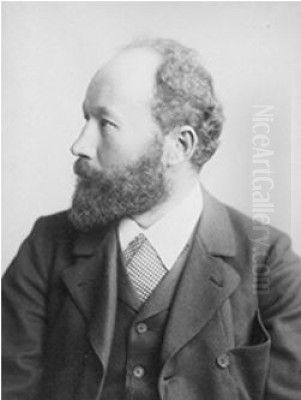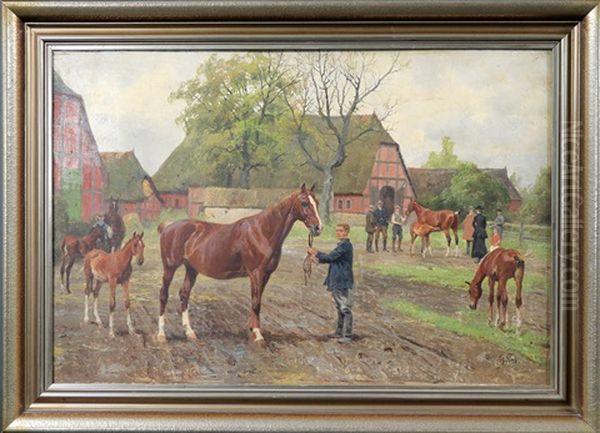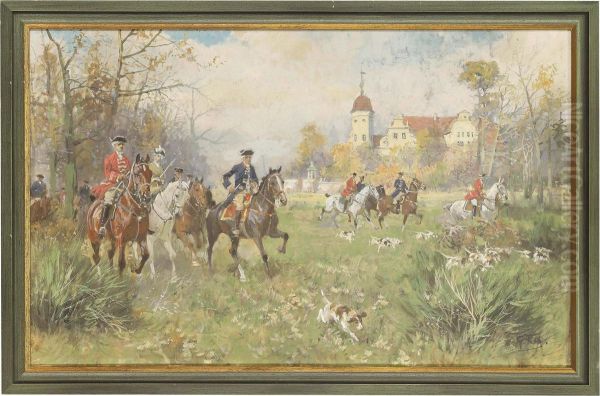
Georg Karl Koch, a notable figure in German art during the late 19th and early 20th centuries, carved a distinct niche for himself as a painter of historical events, dynamic sporting scenes, and meticulously observed animal subjects. Born in Berlin in 1857 and passing away in the same city in 1931 (some sources suggest 1930), Koch's career spanned a period of significant artistic transition in Germany, yet he remained largely dedicated to a realist tradition, infused with the narrative power demanded by his chosen genres. His work, while perhaps not as revolutionary as some of his contemporaries who embraced Impressionism or Expressionism, holds a significant place for its technical skill, its contribution to popular visual culture through panoramas, and its dedicated portrayal of subjects that resonated with the interests of his time.
Early Life and Artistic Foundations in Berlin
Georg Karl Koch's journey into the world of art began in a familial setting, as he was born into an artist's household. His initial training was under the guidance of his father, Karl K. Koch, providing him with a foundational understanding of artistic principles from a young age. This early exposure undoubtedly shaped his inclination towards a career in the arts. To further hone his skills and broaden his artistic horizons, Koch enrolled in the prestigious Berlin Academy of Arts (Akademie der Künste).
At the Academy, Koch had the privilege of studying under several influential artists who were prominent figures in the Berlin art scene. Among his instructors were K. Steffcken (also cited as K. Steffensen), Paul Meyerheim, and Carl Gussow. Each of these mentors likely contributed different facets to Koch's artistic development. Paul Meyerheim (1842-1915), for instance, was himself a highly regarded painter known for his animal portraits, genre scenes, and depictions of exotic locales, and his influence can be seen in Koch's later specialization in animal painting. Meyerheim's own detailed and empathetic portrayal of animals would have provided a strong model for Koch.

Carl Gussow (1843-1907) was another significant teacher, known for his realist portraits and genre paintings. Gussow was a proponent of accurate observation and unembellished representation, a stylistic leaning that would have reinforced Koch's own tendencies towards detailed realism, particularly crucial for historical and animal depictions where accuracy is often paramount. The academic training under such masters would have equipped Koch with a strong command of draughtsmanship, composition, and the traditional techniques of oil painting, which became hallmarks of his mature style. This rigorous academic grounding provided the bedrock upon which he built his career, enabling him to tackle complex multi-figure compositions and large-scale works with confidence.
The Era of Grand Panoramas and Collaboration
In the earlier part of his career, Georg Karl Koch became known for his involvement in the creation of large-scale panoramic paintings. Panoramas were a hugely popular form of public entertainment and visual storytelling in the 19th century, offering immersive experiences of historical battles, exotic landscapes, or significant contemporary events. These colossal circular paintings, often housed in specially constructed rotundas, aimed to transport the viewer directly into the scene.
During this period, Koch frequently collaborated with Eugen Bracht (1842-1921). Bracht was a distinguished German landscape painter, initially associated with the Düsseldorf school and later a professor at the Berlin Academy himself. He was known for his atmospheric landscapes, often depicting moody, expansive natural scenes, and later, more impressionistic works. The collaboration between Koch, with his developing skills in figure and animal painting, and Bracht, a master of landscape and atmosphere, would have been a synergistic one, ideal for the multifaceted demands of panorama production. Panoramas often required artists with diverse specializations to work together to complete the vast canvases, with some focusing on landscape elements, others on figures, and yet others on specific details like military uniforms or architectural features.
While specific titles of panoramas solely attributed to Koch or his direct, detailed contributions are not always extensively documented in easily accessible summaries, his association with this genre and his work alongside a prominent artist like Bracht underscore his capability in handling ambitious, large-format compositions. This experience would have been invaluable, honing his skills in perspective, large-scale design, and the depiction of dramatic action, all of which would later inform his historical and sporting paintings. The discipline required for panorama painting, with its emphasis on illusionism and detailed realism to convince the viewer, further solidified his commitment to representational accuracy. Other artists also engaged in this popular medium, such as Anton von Werner, who was famous for his Sedan Panorama, and Louis Braun, known for his battle panoramas, highlighting the competitive and collaborative environment of this art form.
A Shift Towards Animal and Sporting Art

Following his work on grand panoramas, Georg Karl Koch's artistic focus began to gravitate more specifically towards animal painting and sporting scenes. This transition allowed him to cultivate a more personal and specialized body of work. His earlier training, particularly under Paul Meyerheim, and his inherent observational skills found a fertile ground in the depiction of animals, especially horses, which feature prominently in many of his known works.
His sporting paintings often captured the dynamism and aristocratic elegance of hunts, equestrian events, and military maneuvers. These subjects were popular among a clientele that appreciated both the skillful rendering of animals in motion and the depiction of their own leisure pursuits or societal roles. Koch's ability to convey the power and grace of horses, the tension of a hunt, or the pageantry of a military parade, made his works in this genre highly sought after. He demonstrated a keen understanding of animal anatomy and behavior, a prerequisite for any successful animalier.
This specialization also included historical scenes, often with a focus on military engagements or moments of national significance where cavalry and horses played a central role. His paintings in this vein combined his skill in animal depiction with narrative clarity and historical detail. The shift from the collaborative, often more anonymous, work of panorama creation to these more focused genres allowed Koch to establish a more distinct artistic identity. He joined a strong tradition of German animal painters, including artists like Heinrich von Zügel (1850-1941), who was renowned for his impressionistic depictions of cattle and other farm animals, and Richard Friese (1854-1918), celebrated for his dramatic portrayals of wildlife, particularly lions and northern European fauna. Koch's work, however, often centered more on domesticated animals in service to humankind, particularly in sporting and military contexts.
Professorship and Recognition
Georg Karl Koch's dedication to his craft and his growing reputation as a skilled painter, particularly in the realms of animal and historical art, led to significant academic recognition. In 1899, he was appointed as a professor in Berlin. This appointment was a testament to his standing within the German art establishment and acknowledged his mastery and ability to impart artistic knowledge to a new generation of students. Holding a professorship at a major art academy was a mark of considerable achievement and respect.
Throughout his career, Koch actively exhibited his works, gaining exposure both nationally and internationally. His paintings were featured in major exhibitions across Europe and even in America. Participation in such exhibitions was crucial for an artist's career, providing opportunities for sales, commissions, and critical appraisal. The inclusion of his work in these prestigious venues indicates that his art was well-received and considered of a high standard by contemporary curators and juries. While he operated within a more traditional academic framework, his skill in his chosen subjects ensured continued interest.
The Berlin art scene during Koch's professorship was vibrant and diverse. While figures like Anton von Werner (1843-1915) represented the established academic tradition, often favored by the imperial court, new movements were also emerging. The Berlin Secession, founded in 1898 and championed by artists like Max Liebermann (1847-1935), Lovis Corinth (1858-1925), and Max Slevogt (1868-1932), challenged the conservative art establishment with their embrace of Impressionism and other modern styles. Koch, as a professor and a practitioner of more traditional genres, would have been part of the academic side of this dynamic, sometimes contentious, artistic landscape. His professorship ensured his influence on students who might pursue various artistic paths, but his own work remained rooted in the detailed realism suitable for his subjects.
Artistic Style and Thematic Concerns
Georg Karl Koch's artistic style was firmly rooted in realism, characterized by meticulous attention to detail, anatomical accuracy, and a commitment to verisimilitude. This approach was particularly well-suited to his primary subjects: historical events, sporting pursuits, and animal portraiture. In his historical and military scenes, accuracy in uniforms, weaponry, and the depiction of specific events was paramount. His paintings often aimed to reconstruct a moment with clarity and narrative force, making the historical or contemporary event accessible and engaging for the viewer.
When depicting animals, especially horses, Koch demonstrated a profound understanding of their anatomy, movement, and character. Whether portraying a cavalry charge, a hunting party, or a formal equestrian portrait, his horses are rendered with vitality and precision. This skill extended to other animals that might feature in his works, such as hunting dogs. His compositions were typically well-structured, often dynamic when depicting action, but always maintaining a sense of order and clarity. The influence of his academic training under figures like Carl Gussow, who emphasized realism, is evident in this consistent approach.
His color palette was generally naturalistic, serving the descriptive purpose of his art. While not an innovator in terms of pushing the boundaries of color theory or brushwork in the way of the Impressionists or Post-Impressionists, Koch's technical proficiency allowed him to create convincing textures, from the sheen of a horse's coat to the fabric of a uniform or the foliage of a landscape setting. His work can be seen as part of a broader European tradition of sporting and animal art, which included artists like the French painter Rosa Bonheur (1822-1899), known for her powerful animal depictions, though Koch's context was distinctly German, often reflecting national themes or aristocratic pastimes. He shared with the elder German master Adolph Menzel (1815-1905) a commitment to detailed observation, though Menzel's scope was broader and his style evolved more significantly over his long career.
Representative Works and Genre Depictions
While a comprehensive, universally cited list of Georg Karl Koch's most famous individual masterpieces can be elusive in generalized art historical summaries, his oeuvre is characterized by certain recurring themes and types of compositions that define his contribution. His reputation rests firmly on his proficiency in history painting, sporting scenes, and animal art.
Many of his known works capture the thrill and pageantry of the hunt. Paintings such as "Jagdgesellschaft im Winterwald" (Hunting Party in Winter Forest) exemplify this genre, showcasing his ability to integrate figures, animals (horses and hounds), and landscape into a cohesive and engaging narrative. These scenes often emphasized the elegance and skill of the riders and the dynamic energy of the animals.
Equestrian subjects in military contexts were another significant area of his output. Works depicting cavalry charges, military reviews, or specific historical battles involving mounted troops allowed Koch to combine his talent for animal painting with the grandeur of historical narration. An example might be a piece like "Attacke des Dragoner-Regiments Nr. 13," which would focus on the drama and precision of a cavalry maneuver. Such paintings served not only as artistic endeavors but also as visual records or commemorations of military prowess and tradition, resonating with the strong sense of nationalism prevalent in Wilhelmine Germany.
Scenes of everyday life involving horses, such as "Pferdemarkt" (Horse Market), also feature in his body of work. These paintings provided an opportunity to depict a variety of horse breeds and human interactions, showcasing his observational skills in a less formal, though still detailed, manner. The depiction of horses was clearly a passion and a forte, whether in the context of aristocratic sport, military action, or rural commerce. His dedication to these themes places him alongside other European specialists in equestrian and sporting art, whose works were valued for both their artistic merit and their accurate portrayal of beloved animals and activities.
Contemporaries and Artistic Milieu
Georg Karl Koch practiced his art during a period of immense artistic ferment and change in Germany and across Europe. His adherence to a more traditional, realist style placed him within a specific segment of the art world, even as modernism was making significant inroads. His teachers, Paul Meyerheim and Carl Gussow, were themselves established figures within the academic system, and their influence undoubtedly reinforced Koch's inclination towards representational art.
His collaboration with Eugen Bracht on panoramas connected him with a leading landscape painter who, while also academically trained, later showed an openness to more impressionistic techniques. This collaboration highlights the practical, often project-based nature of certain artistic endeavors of the time. In the specialized field of animal painting, Koch's German contemporaries included figures like Heinrich von Zügel, whose looser, more light-filled depictions of animals offered a contrast to Koch's typically tighter rendering, and Richard Friese, who focused more on wild animals in dramatic natural settings.
The dominant figure in official Berlin art circles for much of Koch's career was Anton von Werner, a favorite of the imperial court, known for his large-scale historical paintings, often depicting Prussian military victories and state ceremonies. Koch's historical and military scenes, while perhaps not on the same grand official scale as some of Werner's major commissions, shared a similar commitment to detailed realism and narrative clarity.
Meanwhile, the rise of the Berlin Secession, with artists like Max Liebermann, Lovis Corinth, and Max Slevogt, represented a significant challenge to the academic art favored by institutions like the Berlin Academy, where Koch taught. These artists championed German Impressionism and later, Expressionist tendencies, advocating for greater artistic freedom and a move away from traditional subject matter and techniques. While Koch was not part of this avant-garde movement, his continued practice and teaching of realist painting ensured the persistence of this tradition. His work would have appealed to a clientele that valued skilled craftsmanship and recognizable subject matter, often related to their social standing, military affiliations, or leisure activities. Other notable German painters of the broader era whose work provides context include the realist Wilhelm Leibl (1844-1900), though more focused on peasant scenes, and the portraitist Franz von Lenbach (1836-1904), a towering figure in Munich.
Legacy and Market Reception
Georg Karl Koch's legacy is that of a skilled and dedicated painter who excelled in specific genres that enjoyed considerable popularity during his lifetime. As a historical, sporting, and animal painter, he fulfilled a demand for art that was both aesthetically pleasing and narratively engaging, often reflecting the values and interests of the German upper and middle classes, as well as military circles. His role as a professor at the Berlin Academy also indicates his contribution to the education of younger artists, perpetuating skills in draughtsmanship and traditional painting techniques.
While he may not be as widely known today as some of the modernist innovators who were his contemporaries, his works continue to appear at auctions and are held in private and potentially some public collections, particularly those specializing in German 19th and early 20th-century art or sporting art. The provided information notes that his paintings have achieved respectable prices at auction, such as a sale in January 2000 for 5600 Euros and another in September 2012 for 2700 Euros. These figures, while not astronomical, suggest a continued appreciation for his technical skill and the appeal of his subject matter among collectors.
His paintings serve as valuable visual documents of their time, capturing aspects of social life, military culture, and the enduring human fascination with animals, particularly the horse. In the broader narrative of art history, Koch represents the continuation of a strong academic and realist tradition that ran parallel to, and sometimes in contrast with, the emerging avant-garde movements. His dedication to his chosen specializations ensured a body of work characterized by consistent quality and a clear understanding of his subjects.
Conclusion
Georg Karl Koch stands as a significant German artist of the late 19th and early 20th centuries, a master of historical, sporting, and animal painting. From his early training under his father and at the Berlin Academy with notable figures like Paul Meyerheim and Carl Gussow, he developed a robust, realist style. His involvement in large-scale panorama projects, often in collaboration with Eugen Bracht, demonstrates his versatility and skill in ambitious compositions. However, it was in his focused depictions of animals, particularly horses, within sporting, military, and historical contexts, that he truly established his reputation. His appointment as a professor in Berlin in 1899 and his participation in major exhibitions across Europe and America attest to his standing in the art world of his time. While operating within a more traditional artistic framework amidst the rise of modernism, Koch's meticulous craftsmanship, his keen observational skills, and his ability to capture the dynamism and character of his subjects ensure his enduring, if specialized, place in the annals of German art. His work continues to be appreciated for its technical excellence and its vivid portrayal of a bygone era.